Module 13: Non Timber Forest Products: Growing Opportunities
Lesson Five - Natural Health From Woodlots
Health and personal care products have become an important segment of the Canadian bioproducts industry. The "wellness revolution" of people seeking foods, nutritional supplements and medicines from natural, forest-based sources has created a booming industry for product suppliers.
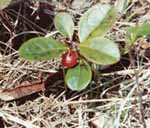 |
|
Teaberry
|
Natural health products can be classified into two categories: nutraceuticals and pharmaceuticals. Nutraceuticals are foods and other products noted to have beneficial effects on the human body, bring a sense of well-being, and may also reduce the risk of chronic disease. Pharmaceuticals are medicines that have a demonstrated history of combatting illness. Together they are worth billions of dollars to the Canadian economy.
How do some of these products come to be on a woodlot?
Many species of forest plants, fungi and other organisms tend to concentrate chemicals in their tissues, or synthesize new ones. Over time, in their close association with the land, First Nations peoples learned to utilize these substances for treating illness, disease and other maladies. This traditional knowledge has been the keystone on which many treatments for human health conditions have been built.
Nutraceuticals
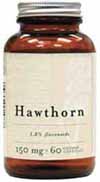 |
|
Hawthorn supplements
|
Canadian forests have been a source of beneficial natural health products for many generations. During the last few years, this concept of "natural health" has become particularly significant. With the people of industrial countries demanding natural products to boost their health and slow the aging process, the market for nutraceuticals and "functional foods" has been robust.
One element of the nutraceutical market that has been growing particularly well is the demand for essential oils. These are plant extracts that have an effect on the sense of well-being of an individual. Their name - essential - comes from their fragrance, or "essence", and does not indicate any critical function.
Essential oils can be found in the leaves, twigs, roots, bark and seeds of plants. They are usually removed from the plant by a process called distillation, which uses steam to remove the oil. A huge amount of raw material is required to produce even a small quantity of product.
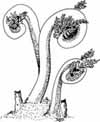 |
|
Fiddleheads
|
An example of a common plant species that has been used to make essential oils is balsam fir. The needles and twigs of fir contain a resin that can be recovered by distillation. The needles and twigs must be fresh for this reason, and the distillation is sometimes done at the forest site. It takes over 100 kilograms of raw balsam firr material to produce 1 kilogram of oil product. Although fir is processed in other areas of Canada, the market for this product still needs to be developed in Nova Scotia.
 |
|
Balsam fir
|
The largest competitor in the neutraceutical market has been conventional foods. However, some people are willing to pay more for foods from natural sources, and these higher prices have been incentives for new producers to enter the marketplace. With 70% of American adults using dietary supplements, and with comparable use in other developed countries, demand for nutraceuticals is immense.
Can wild products meet this market?
Wildcrafters are constantly faced with the scattered nature of wild plants, which take increased time and energy to gather. Added to this are the risks of over-harvesting wild products. How then is this enormous market for natural products to be met?
To meet this demand, many forest plants beneficial to human health have been cultivated. Raised in controlled conditions, however, some of these plants lose a portion of their potency. As a result, there is still a significant demand for products grown in a forest environment.
Following are examples of nutraceuticals that are found on many woodlots in Nova Scotia.
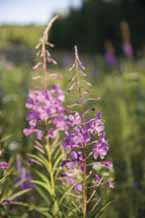 |
|
Fireweed
|
Fireweed
Common on recently logged sites and on burned areas (hence the name), fireweed (Epilobium sp.) is a favoured source of nectar for honey production. Beekeepers often position their hives close to sites with fireweed, since the honey produced is considered superior to that from agricultural sources.
Fireweed extract is used in producing a salve that soothes sunburn, and has been documented as an anti-inflammatory.
Blueberries
Wild blueberries are valued for their antioxidant properties that can help protect the circulatory system, guard against arthritis and prevent some of the complications of diabetes. With this many benefits, it is no surprise that blueberry sales are healthy.
A related fruit, bilberry, was used by British pilots in World War II to improve their night vision. While blueberries are not as rich in beneficial anthocyanins as bilberries, they are still considered to be very beneficial.
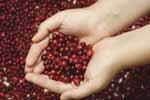 |
|
Cranberries
|
Cranberries
A good source of health-beneficial antioxidants are cranberries, which grow in wet forest areas such as bogs. Despite extensive cultivation, there is still a demand for wild cranberries, which are claimed to boost good cholesterol and maintain a healthy vascular system.
Other Nutraceutical NTFPs
An ingredient of some natural drinks is Labrador tea (Ledum groenlandicum). The leaves of this plant can be dried and made into teas which are claimed to have a mildly relaxing effect. This shrub grows in poorly drained forested areas. The leaves of wintergreen (Gaultheria procumbens) and other plants can also be made into teas.
 |
|
Labrador tea
|
The weight-loss industry is worth billions of dollars to the Canadian economy, and has noticeably moved in the direction of natural products. One of these products is a form of sugar, xylitol, which is less complex than sugars derived from beets or cane. Xylitol is found in the bark of white birch, and was used in Scandinavia after World War II when beet sugar was scarce. This sugar is claimed to have health-boosting properties in addition to its light, sweet taste.
Some derivatives of the wood pulp-making process have been used in health food products. A Finnish company has manufactured a margarine from pulp extracts, claiming it lowers blood cholesterol levels by 10 percent.
Pharmaceuticals
Canada is a primary producer of raw materials for the world pharmaceutical market. These materials are manufactured into drugs and imported back to Canada as finished products. World demand for medicinal plants is escalating, and about one-quarter of all prescription drugs sold in the US contain plant materials or extracts.
 |
|
Ground hemlock
|
Most medicinal plants found in the woodlands of Nova Scotia can be cultivated as agricultural crops. This kind of setting ensures quantity of plant material and quality control for large drug manufacturers. However, it also requires pest control and other increased costs associated with agricultural crops.
For small scale enterprises, gathering of wild medicinals can remain an option. Browse any number of old books on home remedies or living off the land, and you'll find many references to medicinal forest plants and herbal medicines.
What are herbal medicines? The World Health Organization defines them as "herbs, herbal materials, herbal preparations and finished herbal products that contain as active ingredients parts of plants, or other plant material, or combinations."
This broad definition includes all of the medicinal plants of Nova Scotia's forests.
Once a product is advertised as treating illness, there may be a requirement to register it under the Canadian Food and Drugs Act. It can take 10 to 12 years for a new drug to reach the marketing stage.
Some of the more common Nova Scotia forest plant species and their pharmaceutical uses are:
| PLANT SPECIES | MEDICINAL USES |
| Ground hemlock | Cancer treatment |
| Fireweed | Acne treatment |
| Dandelion | Digestive aid |
| Witch hazel | Skin lotions, reduce varicose veins |
| Hawthorn | Strengthen vascular system |
 |
|
Ground hemlock processing
|
While many people have heard of ground hemlock and its cancer-fighting qualities, few realize that it takes about 30,000 kilograms of raw material to make 1 kilogram of the medicinal product paclitaxel. There is ongoing research into ways to more effectively cultivate this plant and maximize its active ingredient potential. In the meantime, it is a favoured food of whitetail deer and wild stocks of ground hemlock will continue to be limited because of browsing by deer.
Because of the commercial success of plant-derived drugs, harvesting pressure on wild stocks is increasing. Some plant species of medicinal importance, such as wild American ginseng, may have already been extirpated from the province.
Caution must be exercised in harvesting any plant material from the wild, especially medicinal plants.
